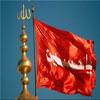Ahlul Bayt News Agency - Muharram is a month of remembrance and modern Shia meditation that is often considered synonymous with Ashura. Ashura, which literally means the "Tenth" in Arabic, refers to the tenth day of Muharram. It is well-known because of historical significance and mourning for the murder of Hussein ibn Ali, the grandson of Prophet Muhammad (PBUT).
Shiite begin mourning from the first night of Muharram and continue for ten nights, climaxing on the 10th of Muharram, known as the Day of Ashura. The last few days up until and including the Day of Ashura are the most important because these were the days in which Imam Hussein and his family and followers (including women, children and elderly people) were deprived of water from the 7th onward and on the 10th, Imam Hussain and 72 of his followers were martyred or subjected to humiliation by the army of tyrant Yazid I at the Battle of Karbala on Yazid's orders. The surviving members of Imam Hussein's family and those of his followers were taken captive, marched to Damascus, and imprisoned there.
The Mourning of Muharram, Remembrance of Muharram, or Muharram Observances, is a set of rituals associated with Shia Islam, which takes place in Muharram, the first month of the Islamic calendar. Many of the events associated with the ritual take place in congregation halls known as Hussainia.
The commemoration of the event during yearly mourning season, from first of Muharram to twentieth of Safar with Ashura comprising the focal date, serves to define Shia communal identity. At present, Muharram Observances are carried around the world from East to West and from North to South.
The words Azadari (Persian: عزاداری) which mean mourning and lamentation; and Majalis-e Aza have been exclusively used in connection with the remembrance ceremonies for the martyrdom of Imam Hussain. Majalis-e Aza, also known as Aza-e Husayn, includes mourning congregations, lamentations, matam and all such actions which express the emotions of grief and above all, repulsion against what tyrant Yazid stood for.
The following photos are the first and second night of series of lectures for the mourning of the tragedy in Karbala with Sheikh Abu Mahdi at Imam Al Mahdi mosque of Zamboanga city, Philippines.
Photos By: Mohammad Mahdi























